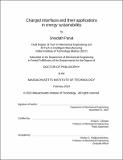Charged interfaces and their applications in energy sustainability
Author(s)
Panat, Sreedath
DownloadThesis PDF (7.185Mb)
Advisor
Varanasi, Kripa K.
Terms of use
Metadata
Show full item recordAbstract
Energy sustainability is one of the most important challenges of the present time. In this thesis we investigate some critical sustainability challenges and develop advanced mitigation approaches for various energy systems. In photovoltaic systems, dust accumulation on solar panels is a global challenge that affects the operational efficiency. Current water-based methods impose a huge water footprint and cost to solar energy. In crude oil extraction, there is significant waste byproduct formed in the form of water-in-oil nanoscale emulsion due to the mixing of underground water and crude oil. To separate water and oil phases toxic chemical demulsifiers are added which along with effluents from the refineries reach waterbodies, harming the local ecosystem. In postcombustion CO₂ capture systems, the absorption of CO₂ from flue gas into a sorbent liquid is capital expensive. The need for large surface area of interaction necessitates the installation of prohibitively expensive absorption towers and the usage of environmentally unfriendly chemicals such as amines. In this thesis, we investigate advanced methods by leveraging interfacial charge to make these renewable and non-renewable energy systems more sustainable and efficient. First, we demonstrate a novel approach based on active electrostatic charge induction for charging and electrostatically repelling dust from solar panels. We show that more than 99% of the lost power output can be recovered by our approach without consuming a single drop of water. Second, we develop a non-Laplacian space charge emitter electrocoalescer setup that allows us to apply nearly 8 times stronger electric field compared to traditional electrocoalescers across water-in-oil emulsion to polarize and coalesce the droplets. Thus, we demonstrate that we can successfully phase separate water-in-oil nanoscale emulsions at timescales relevant for crude oil processing systems, while completely eliminating the use of toxic demulsifiers. Finally, we introduce mist-scale droplets for significantly enhancing the interfacial area of interaction between flue gas and the sorbent liquid. We introduce electrostatic space charge injection approach to charge and collect the CO₂-absorbed mist droplets at nearly 100% efficiency. Overall, our approach leads to more than 95% CO₂ absorption at 2.6-fold reduction in carbon capture capital cost.
Date issued
2023-02Department
Massachusetts Institute of Technology. Department of Mechanical EngineeringPublisher
Massachusetts Institute of Technology